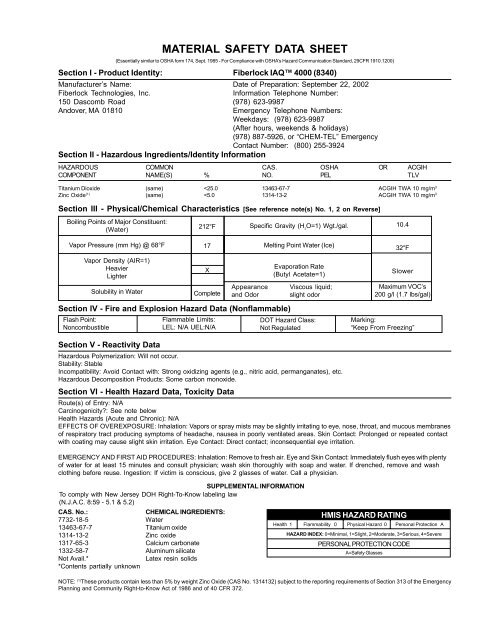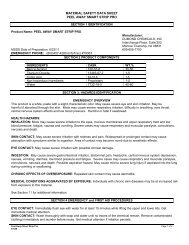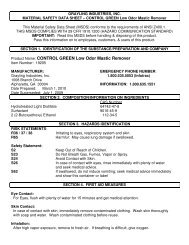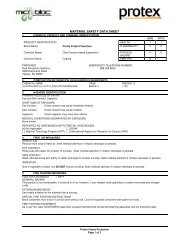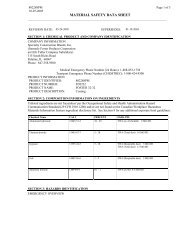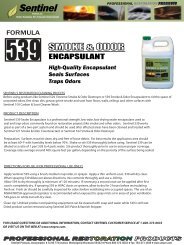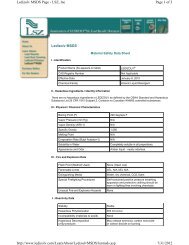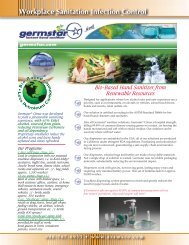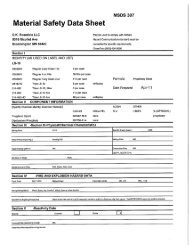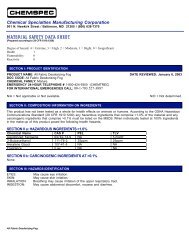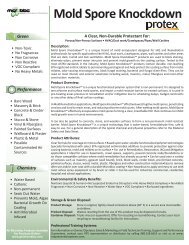MATERIAL SAFETY DATA SHEET - Aramsco
MATERIAL SAFETY DATA SHEET - Aramsco
MATERIAL SAFETY DATA SHEET - Aramsco
Create successful ePaper yourself
Turn your PDF publications into a flip-book with our unique Google optimized e-Paper software.
<strong>MATERIAL</strong> <strong>SAFETY</strong> <strong>DATA</strong> <strong>SHEET</strong><br />
(Essentially similar to OSHA form 174, Sept. 1985 - For Compliance with OSHA’s Hazard Communication Standard, 29CFR 1910.1200)<br />
Section I - Product Identity: Fiberlock IAQ 4000 (8340)<br />
Manufacturer’s Name: Date of Preparation: September 22, 2002<br />
Fiberlock Technologies, Inc.<br />
Information Telephone Number:<br />
150 Dascomb Road (978) 623-9987<br />
Andover, MA 01810<br />
Emergency Telephone Numbers:<br />
Weekdays: (978) 623-9987<br />
(After hours, weekends & holidays)<br />
(978) 887-5926, or “CHEM-TEL” Emergency<br />
Contact Number: (800) 255-3924<br />
Section II - Hazardous Ingredients/Identity Information<br />
HAZARDOUS COMMON CAS. OSHA OR ACGIH<br />
COMPONENT NAME(S) % NO. PEL TLV<br />
Titanium Dioxide (same)
Section VII: Precautions for Safe Handling and Use<br />
STEPS TO BE TAKEN IN CASE <strong>MATERIAL</strong> IS RELEASED OR SPILLED: Keep unnecessary people away.<br />
Floor may be slippery; use care to avoid falling. Dike and contain material with inert material (e.g. sand, earth).<br />
Transfer liquid to containers for recovery or disposal and solid diking material to separate containers for disposal.<br />
Keep spills and run-offs out of municipal sewers and open bodies of water.<br />
WASTE DISPOSAL METHOD: The coating and any contaminated diking material should be thoroughly air dried<br />
and collected into drums. The drums should then be sealed and properly labeled with waste designation and<br />
disposed of in a landfill or incinerated according to current local, state and federal regulations.<br />
PRECAUTIONS TO BE TAKEN IN HANDLING AND STORING: Maximum storage temperature 100°F. Keep<br />
closure tight and container upright to prevent leakage. Precautionary Labeling: “Keep from Freezing”.<br />
OTHER PRECAUTIONS: Do not get in eyes. Avoid skin contact. Prevent prolonged or repeated breathing of<br />
vapors or spray mists. Do not handle until the manufacturer’s safety precautions and label instructions have<br />
been read and understood. Avoid breathing sanding dust.<br />
Section VIII: Control Measures<br />
RESPIRATORY PROTECTION: None required if good ventilation is maintained. Wear respirator (MSHA/NIOSHapproved<br />
or equivalent) suitable for concentrations and types of air contaminants encountered. Use approved<br />
chemical/mechanical filters designed to remove particulates in open and restricted ventilation areas. Use MSHA/<br />
NIOSH-approved airline type respirators or hood in confined areas.<br />
VENTILATION: Sufficient ventilation, in pattern and volume, should be provided to keep the air contaminant<br />
concentration below applicable exposure limits. All application areas should be ventilated in accordance with<br />
OSHA regulation 29CFR Part 1910.94.<br />
PROTECTIVE GLOVES: Impervious gloves should be worn if prolonged skin contact is likely. Use neoprene or<br />
rubber gloves to prevent prolonged skin contact.<br />
EYE PROTECTION: Use safety eyewear including side shields, face shields, or chemical splash goggles<br />
(ANSIZ-87.1 or approved equivalent).<br />
OTHER PROTECTIVE EQUIPMENT: Use disposable or impervious clothing if work clothing contamination is<br />
likely. Use protective cream if prolonged skin contact is likely.<br />
HYGIENIC PRACTICES: Wash hands before eating, smoking, or using the washroom. Food or beverages<br />
should not be consumed anywhere this product is being applied.<br />
References:<br />
1. Sax, N.I., “Dangerous Properties of Industrial Materials”, 8th ed., Van Nostrand Reinhold Company, Inc.,<br />
NY, 1992.<br />
2. American Conference of Governmental Industrial Hygienists, “TLV’s and Biological Exposure Indices” for<br />
the current year (published annually).<br />
3. U.S. Code of Federal Regulations (CFR) U.S. Dept. of Labor, No. 29, Parts 1900 to 1910.1200. OSHA<br />
Communications Standard 29 CFR 1910.1200.<br />
4. Sax, N.I., R.J. “Hazardous Chemicals Desk Reference”, Van Nostrand Reinhold Co., Inc., NY, 1987.<br />
5. Fire Protection Guide to Hazardous Materials, 12th edition, National Fire Protection Association, Quincy,<br />
MA, 1997.<br />
6. Title III List of Lists, U.S. Environmental Protection Agency publication EPA 560/4-90-011, January 1990.


